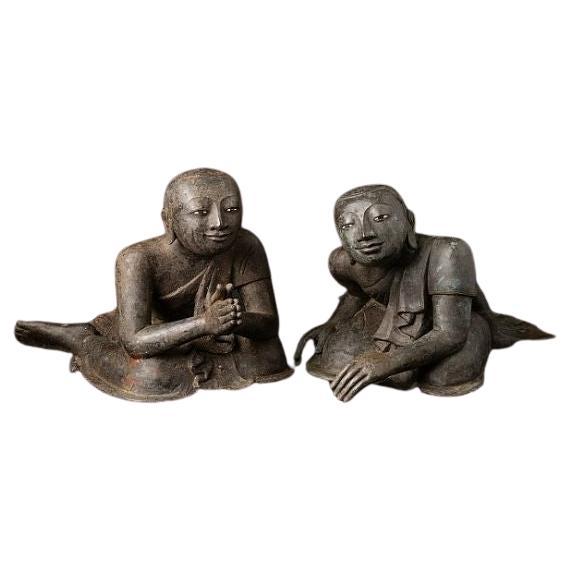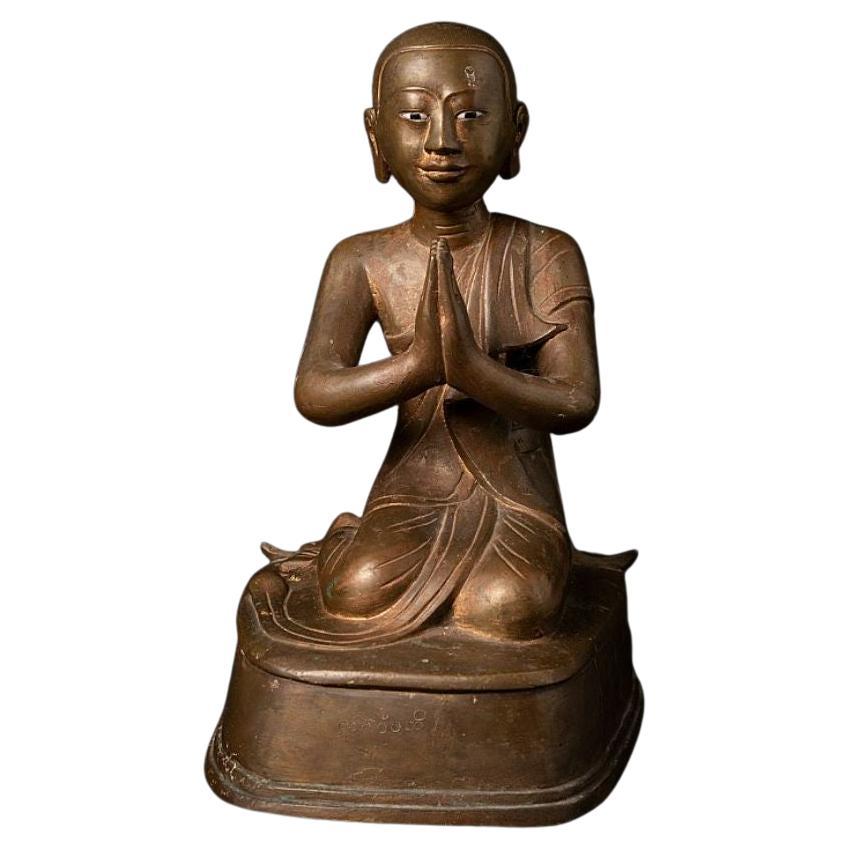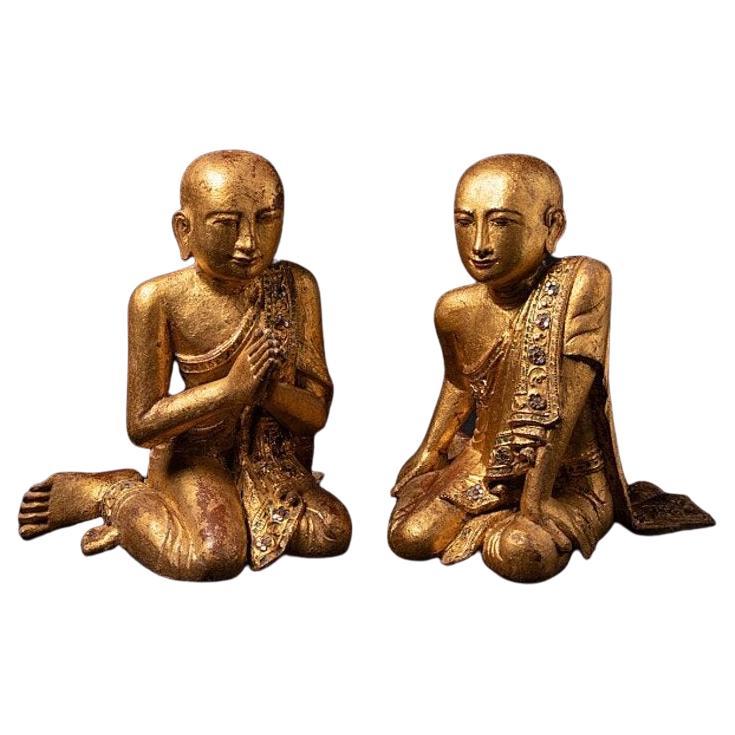Items Similar to Pair of Antique Bronze Burmese Monk Statues from Burma
Want more images or videos?
Request additional images or videos from the seller
1 of 21
Pair of Antique Bronze Burmese Monk Statues from Burma
About the Item
Material: bronze
37 cm high
20 cm wide and 26,5 cm deep
Weight: 19.883 kgs
Mandalay style
Namaskara mudra
Originating from Burma
Late 19th century.
- Dimensions:Height: 14.57 in (37 cm)Width: 7.88 in (20 cm)Depth: 10.44 in (26.5 cm)
- Materials and Techniques:
- Place of Origin:
- Period:
- Date of Manufacture:Late 19th Century
- Condition:Wear consistent with age and use.
- Seller Location:DEVENTER, NL
- Reference Number:
About the Seller
5.0
Gold Seller
These expertly vetted sellers are highly rated and consistently exceed customer expectations.
Established in 1997
1stDibs seller since 2022
20 sales on 1stDibs
Typical response time: 9 hours
- ShippingRetrieving quote...Ships From: DEVENTER, Netherlands
- Return PolicyA return for this item may be initiated within 14 days of delivery.
More From This SellerView All
- Pair of Antique Bronze Burmese Monk Statues from BurmaLocated in DEVENTER, NLMaterial: bronze Measures: 26,5 cm high 33 cm wide and 42 cm deep Weight: 20.15 kgs Namaskara mudra Originating from Burma Late 19th century With inlayed eyes.Category
Antique Late 19th Century Burmese Sculptures and Carvings
MaterialsBronze
- Pair of Antique Bronze Monk Statues from BurmaLocated in DEVENTER, NLMaterial: bronze 31,5 cm high 37 cm wide and 47 cm deep Weight: 31.9 kgs Namaskara mudra Originating from Burma Late 19th century With inlayed eyes.Category
Antique Late 19th Century Burmese Sculptures and Carvings
MaterialsBronze
- Antique bronze Burmese Monk statue from BurmaLocated in DEVENTER, NLMaterial: bronze 31 cm high 18,8 cm wide and 23,6 cm deep Weight: 4.034 kgs Mandalay style Namaskara mudra Originating from Burma Late 19th century With Burmese inscriptions...Category
Antique Late 19th Century Burmese Sculptures and Carvings
MaterialsBronze
- Antique Pair of Monk Statues from BurmaLocated in DEVENTER, NLMaterial: wood 32,5 cm high 30,5 cm wide and 26,3 cm deep Weight: 4.95 kgs Gilded with 24 krt. gold Mandalay style Namaskara mudra Originating from Burma 19th century.Category
Antique 19th Century Burmese Sculptures and Carvings
MaterialsWood
- Pair of Antique Monk Statues from BurmaLocated in DEVENTER, NLMaterial: wood 29,5 cm high Both 23,5 cm wide and 27 cm deep Weight: 4.2 kgs Gilded with 24 krt. gold Namaskara mudra Originating from Burma 19th century Special !.Category
Antique 19th Century Burmese Sculptures and Carvings
MaterialsWood
- Pair of Antique Monk Statues from BurmaLocated in DEVENTER, NLMaterial: wood. Measures: 21, 3 cm high. 13, 8 cm wide and 16,5 cm deep. Weight: 1.284 kgs. Gilded with 24 krt. gold. Namaskara mudra. Originating from Burma. Early 20th centu...Category
Early 20th Century Burmese Sculptures and Carvings
MaterialsWood
You May Also Like
- Large Pair of Antique Style Bronze Thai Praying BuddhasLocated in Stamford, CTLarge pair of antique style bronze Thai kneeling and praying Buddhas. Intricate detail, gilt head piece. Probably mid 20th century.Category
Mid-20th Century Thai Sculptures and Carvings
MaterialsBronze
- Chinese Jade Statue of a Confucian SageLocated in Milano, ITSplendid statue made of jade in the typically Chinese 19th century. The statue is very beautiful and rests on an oval base made of very fine dark wood. The lower part of the statue ...Category
Antique Early 1800s Chinese Chinese Export Sculptures and Carvings
MaterialsJade
- Large Burmese Bronze Medicine Buddha, Pagan Style, Late 19th CenturyLocated in Austin, TXA large and magnificent cast bronze image of the Medicine Buddha, Bhaisajyaguru, rendered in the Burmese Pagan style, and most likely based on a period example that was either damaged or lost, 19th century, Burma or Thailand. He can be identified as the Medicine Buddha by the hand that rests in his lap, with his middle finger touching the thumb. A medicine pot or fruit stem would originally have been placed in his upturned palm. The face of this Buddha has been sculpted masterfully. He has a beautiful heart shaped face topped by hair neatly arranged in the typical "snail shell curls", and surmounted by a high ushnisha. Long, pendulous earlobes frame his face, a symbol of his princely past. He gazes serenely outwards from heavily lidded, downcast eyes, a content smile upon his full, lush lips. The Buddha is portrayed seated in vajrasana (full lotus position), his elegant hands displayed in varada mudra, the gesture of granting favors and fulfilling wishes. Long, exquisite fingers extended, the thumb and middle finger touching in a gesture of compassion. He is clothed in a simple kasaya wrapped around his body and over one shoulder, leaving the shoulder and part of his chest bare. The diaphanous garment clings to his body, outlining his well proportioned and graceful, almost sensuous, form. The excess material pooled in neat pleats in front of him. A sash thrown over his shoulder. He sits upon a double lotus base upon a raised platform. The platform features two kneeling attendants, usually interpreted as the monks Ananda and Kasyapa. Between them is a circular disc representing the Wheel of Dharma. Contained in the disk is a flower with eight petals, symbolizing the eightfold path, one of the principle teachings of the Buddha. The sides and back of the platform featuring a series of singha, or lions, representative of the Buddha's royal past. An applied lacquer patina covers the entirety of the image. Large deposits of ash (from incense) are present between the curls of the hair, as well as some the other crevices, indicating this image was the subject of worship for many years. Bhaisajyaguru, also called the Medicine Buddha, or Buddha of Healing, is a revered figure in the Buddhist pantheon as a master able to cure suffering, both physical and spiritual, through his teachings. The Pagan Empire ruled most of present day Burma (Myanmar) from 849 to 1297. The capital, Bagan, served as a both the center of government and religion, where Buddhism reigned supreme. Bagan was also at a crossroads of the Buddhist world, with influence from India, Nepal, Tibet, China, and even Indonesia shaping their culture. As such, Pagan Buddha...Category
Antique Late 19th Century Burmese Sculptures and Carvings
MaterialsBronze
- Japanese Antique 'KOMAINU' Shrine Guardian Dog Statues 1600s-1700s / WabisabiLocated in Sammu-shi, ChibaThis is a very old Japanese "KOMAINU". It is an item from the early Edo period (1600s-1700s). It is carved from cedar wood. A-Un," or "A-Un," is the Japanese word for "guardian dog....Category
Antique Late 17th Century Japanese Edo Sculptures and Carvings
MaterialsCedar
- Han Dynasty Statue of Standing Guardian, Oxford TL Test CertificateLocated in Greenwich, CTAn elegant statue of standing guardian, benevolent facial expression, fine details, Han dynasty 206BC-220AD. Come with Oxford TL test certificate.Category
Antique 15th Century and Earlier Chinese Han Sculptures and Carvings
MaterialsTerracotta
- Pair of Early 20th Century Carved Marapcchi Bommais Dolls from Southern IndiaLocated in Atlanta, GAThese finely carved pair of Indian dolls are known as Marapachi Bommais, which literally translates to ‘wooden dolls’. Marapachi Bommais dolls are an important part of South Indian culture and rituals. These dolls which are usually in a pair as a bride and groom and is a part of the Golu display done in households during Navaratri. Marapachi Bommai hold great sentimental value as they are given as part of the bride’s wedding trousseau and are a legacy passed on from one generation to another in the states of Tamil Nadu, Karnataka and Andhra Pradesh. The dolls are in naked form and are typically decorated with clothes and finery by children as their playthings. The female doll...Category
Early 20th Century Indian Sculptures and Carvings
MaterialsWood





